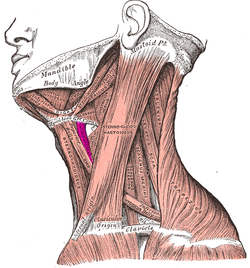| Thyrohyoid muscle | |
|---|---|
 Muscles of the neck. Lateral view. (Thyrohyoideus labeled center-left.) Muscles of the neck. Lateral view. (Thyrohyoideus labeled center-left.) | |
 Muscles of the neck. Anterior view. (Thyrohyoideus visible center-left.) Muscles of the neck. Anterior view. (Thyrohyoideus visible center-left.) | |
| Details | |
| Origin | Thyroid cartilage of the larynx |
| Insertion | Hyoid bone |
| Artery | Superior thyroid artery |
| Nerve | First cervical nerve (C1) via hypoglossal nerve |
| Actions | Elevates thyroid and depresses the hyoid bone |
| Identifiers | |
| Latin | musculus thyrohyoideus |
| TA98 | A04.2.04.007 |
| TA2 | 2174 |
| FMA | 13344 |
| Anatomical terms of muscle[edit on Wikidata] | |
The thyrohyoid muscle is a small skeletal muscle of the neck. Above, it attaches onto the greater cornu of the hyoid bone; below, it attaches onto the oblique line of the thyroid cartilage. It is innervated by fibres derived from the cervical spinal nerve 1 that run with the hypoglossal nerve (CN XII) to reach this muscle. The thyrohyoid muscle depresses the hyoid bone and elevates the larynx during swallowing. By controlling the position and shape of the larynx, it aids in making sound.
Structure
The thyrohyoid muscle is a small, broad and short muscle. It is quadrilateral in shape. It may be considered a superior-ward continuation of sternothyroid muscle.
It belongs to the infrahyoid muscles group and the outer laryngeal muscle group.
Attachments
Its superior attachment is the inferior border of the greater cornu of the hyoid bone and adjacent portions of the body of hyoid bone.
Its inferior attachment is the oblique line of the thyroid cartilage (alongside the sternothyroid muscle).
Innervation
The thyrohyoid muscle is innervated (along with the geniohyoid muscle) by a branch of the cervical plexus - the nerve to thyrohyoid muscle (thyrohyoid branch of ansa cervicalis) - which is formed by fibres of the cervical spinal nerve 1 (C1) (and - according to some sources - cervical spinal nerve 2 as well) that join and travel with the hypoglossal nerve (CN XII) before splitting away from it distal to the superior root of ansa cervicalis. The thyrohyoid muscle is the only infrahyoid muscle that is not innervated via the ansa cervicalis.
Blood supply
The muscle is provided with arterial blood by branches of the superior thyroid artery, and of the lingual artery.
Relations
The thyrohyoid muscle forms the inferior boundary of the carotid triangle. It is situated deep to (beneath) the (depending upon the source) superior portion of/superior belly of the sternohyoid muscle, and the superior portion of the omohyoid muscle.
Function
The thyrohyoid muscle depresses and fixates the hyoid bone. It elevates the larynx during swallowing. By controlling the position and shape of the larynx, it aids in making sound.
Additional images
| This gallery of anatomic features needs cleanup to abide by the medical manual of style. Galleries containing indiscriminate images of the article subject are discouraged; please improve or remove the gallery accordingly. (May 2015) |
-
 Hyoid bone. Anterior surface. Enlarged.
Hyoid bone. Anterior surface. Enlarged.
-
 The veins of the thyroid gland.
The veins of the thyroid gland.
-
 Hypoglossal nerve, cervical plexus, and their branches.
Hypoglossal nerve, cervical plexus, and their branches.
-
 The right brachial plexus with its short branches, viewed from in front.
The right brachial plexus with its short branches, viewed from in front.
-
 Side view of the larynx, showing muscular attachments.
Side view of the larynx, showing muscular attachments.
-
Thyrohyoid muscle
See also
Notes
- Described as either the origin or as the insertion.
- Described as either the origin or as the insertion.
References
![]() This article incorporates text in the public domain from page 394 of the 20th edition of Gray's Anatomy (1918)
This article incorporates text in the public domain from page 394 of the 20th edition of Gray's Anatomy (1918)
- ^ Standring, Susan (2020). Gray's Anatomy: The Anatomical Basis of Clinical Practice (42th ed.). New York. p. 582. ISBN 978-0-7020-7707-4. OCLC 1201341621.
{{cite book}}: CS1 maint: location missing publisher (link) - ^ Sinnatamby, Chummy S. (2011). Last's Anatomy (12th ed.). Elsevier Australia. p. 337. ISBN 978-0-7295-3752-0.
- ^ Waschke, Jens; Böckers, Tobias M.; Paulsen, Friedrich; Arnold, Wolfgang; Bechmann, Ingo, eds. (2018). Sobotta Anatomy Textbook: English Edition with Latin Nomenclature (1st ed.). München: Elsevier. ISBN 978-0-7020-6760-0.
- ^ "ramus thyrohyoideus ansae cervicalis". TheFreeDictionary.com. Retrieved 2023-06-30.
- Luna, Mario A.; Pfaltz, Madeleine (2009). "11 - Cysts of the Neck, Unknown Primary Tumor, and Neck Dissection". Diagnostic Surgical Pathology of the Head and Neck (2nd ed.). Philadelphia: Saunders. pp. 839–881. doi:10.1016/B978-1-4160-2589-4.00011-5. ISBN 978-1-4377-1951-2. OCLC 460904310.
- Hage, Steffen R. (2010). "8.3 - Neuronal networks involved in the generation of vocalization". Handbook of Behavioral Neuroscience. Vol. 19. Stefan Brudzynski. London: Academic Press. pp. 339–349. doi:10.1016/B978-0-12-374593-4.00032-2. ISBN 978-0-12-374593-4. ISSN 1569-7339. OCLC 528610774.
External links
- Anatomy photo:25:03-0106 at the SUNY Downstate Medical Center
- Anatomy photo:25:10-0105 at the SUNY Downstate Medical Center
- "Anatomy diagram: 25420.000-1". Roche Lexicon - illustrated navigator. Elsevier. Archived from the original on 2015-02-26.
- PTCentral
| Muscles of the neck | |
|---|---|
| Cervical | |
| Suboccipital | |
| Suprahyoid | |
| Infrahyoid | |
| Pharynx | |
| Larynx | |
| Trachea | |
| Fasciae | |